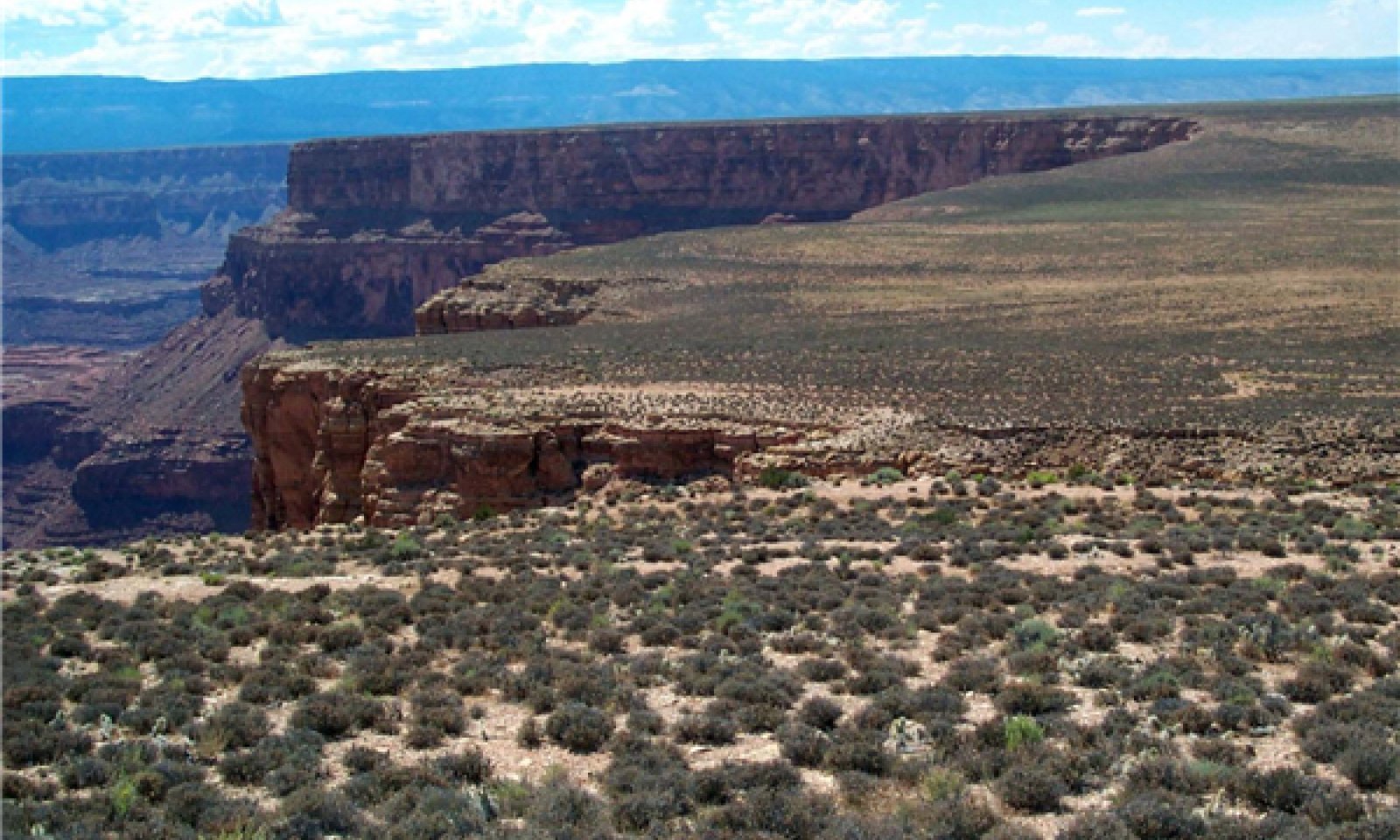

Natural Resources
Conservation Service
Ecological site R035XC333AZ
Sandstone Upland 10-14" p.z. Warm
Last updated: 5/19/2025
Accessed: 12/21/2025
General information
Provisional. A provisional ecological site description has undergone quality control and quality assurance review. It contains a working state and transition model and enough information to identify the ecological site.
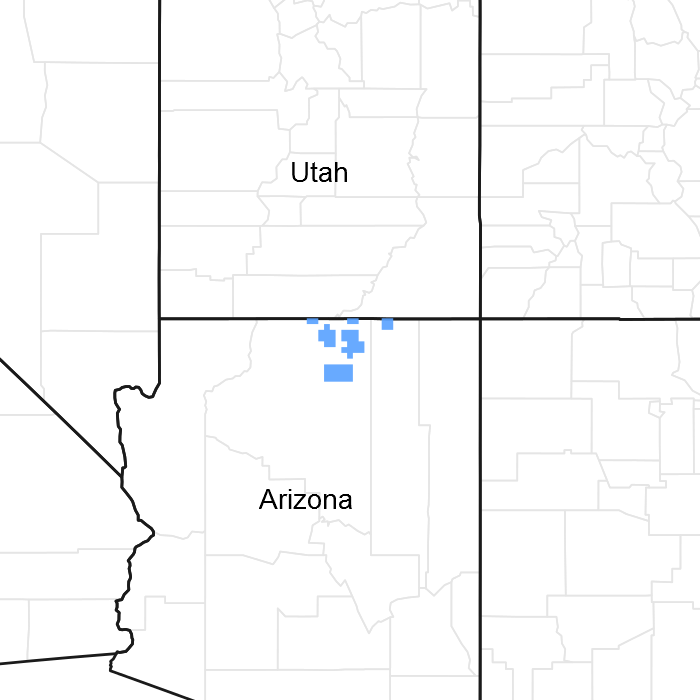
Figure 1. Mapped extent
Areas shown in blue indicate the maximum mapped extent of this ecological site. Other ecological sites likely occur within the highlighted areas. It is also possible for this ecological site to occur outside of highlighted areas if detailed soil survey has not been completed or recently updated.
MLRA notes
Major Land Resource Area (MLRA): 035X–Colorado Plateau
This ecological site is found in Common Resource Area 35.3 – the Colorado Plateau Sagebrush – Grasslands.
The Common Resource Area occurs within the Colorado Plateau Physiographic Province. It is characterized by a sequence of flat to gently dipping sedimentary rocks eroded into plateaus, valleys and deep canyons. Elevations range from 4800 to 6700 feet and precipitation averages 10 to 14 inches. The elevation range is lower (about 4500 to 6000 ) on the western side of the Colorado Plateau along the Grand Canyon, and moves up about 500 to 800 feet higher on the eastern side in the areas of the Navajo and Hopi Indian Reservations due to rain shadow effects from the Kaibab Plateau and Mogollon Rim. Common vegetation in this region includes Wyoming big sagebrush, Utah juniper, Colorado pinyon - cliffrose, Mormon tea, fourwing saltbush, blackbrush Indian ricegrass, needle and thread, western wheatgrass Galleta, black grama, blue grama, and sand dropseed. Sedimentary rock classes dominate the plateau with volcanic fields occurring for the most part near its margin. The soil temperature regime is mesic and the soil moisture regime is ustic aridic.
Ecological site concept
Soils grouped in this site are shallow to bedrock Surface and subsoil textures are loamy fine sand, sand and loamy sand. Parent material is sandstone. Water erosion potential is severe and wind erosion potential is high. This ecological site occurs on structural benches, cuestas and hills. Slopes typically range from 1 to 15 percent.
Table 1. Dominant plant species
| Tree |
(1) Juniperus osteosperma |
|---|---|
| Shrub |
(1) Coleogyne ramosissima |
| Herbaceous |
(1) Bouteloua gracilis |
Physiographic features
This site is on structural benches, cuestas and hills, specific landform and position is convex slopes on plateaus.
Table 2. Representative physiographic features
| Landforms |
(1)
Plateau
(2) Cuesta |
|---|---|
| Flooding duration | Very brief (4 to 48 hours) to extremely brief (0.1 to 4 hours) |
| Flooding frequency | None to rare |
| Ponding frequency | None to rare |
| Elevation | 4,800 – 6,700 ft |
| Slope | 1 – 15% |
| Aspect | Aspect is not a significant factor |
Climatic features
Winter summer moisture ratios range from 70:30 to 60:40. Late spring is usually the driest period, and early fall moisture can be sporadic. Summer rains fall from June through September; moisture originates in the Gulf of Mexico and creates convective, usually brief, intense thunderstorms. Cool season moisture from October through May tends to be frontal; it originates in the Pacific and the Gulf of California and falls in widespread storms with longer duration and lower intensity. Precipitation generally comes as snow from December through February. Accumulations above 12 inches are not common but can occur. Snow usually lasts for 3-4 days, but can persist much longer. Summer daytime temperatures are commonly 95 - 100 F and on occasion exceed 105 F. Winter air temperatures can regularly go below 10 F and have been recorded below - 20 F.
Table 3. Representative climatic features
| Frost-free period (average) | 168 days |
|---|---|
| Freeze-free period (average) | 193 days |
| Precipitation total (average) | 14 in |
Figure 2. Monthly precipitation range
Figure 3. Monthly average minimum and maximum temperature
Influencing water features
This site occurs in an upland position. The soil moisture on this ecological site comes from precipitation. It does not benefit from run-in moisture but does sustains excessive runoff.
Soil features
Soils are shallow with depth to bedrock 10" to 20". Surface and subsoil textures are loamy fine sand, sand and loamy sand. Parent material is sandstone. Geologic formation is various sandstone formations. Available water capacity is very low. Water erosion potential is severe; wind erosion potential is high. Soils are non-saline, non-sodic with a pH range of 7.4-8.4. The soil moisture regime is ustic aridic. The soil temperaturee regime is mesic. Soils are calcareous at soil surface.
Typical taxonomic units on this site include:
SSA 629 Coconino County North Kaibab part MU 38 Arches;
SSA 707 Little Colorado River Area MU's 1 & 32 Arches, 46-Nalcase;
SSA 711 Navajo Mountain Area MU's 25 & 41 Rizno, 26-Arches and 43-Rock Outcrop.
Table 4. Representative soil features
| Parent material |
(1)
Residuum
–
sandstone
|
|---|---|
| Surface texture |
(1) Loamy fine sand (2) Sand (3) Loamy sand |
| Family particle size |
(1) Sandy |
| Drainage class | Well drained to excessively drained |
| Permeability class | Rapid to very rapid |
| Soil depth | 10 – 20 in |
| Surface fragment cover <=3" | 35% |
| Surface fragment cover >3" | 35% |
| Available water capacity (0-40in) |
2.5 in |
| Calcium carbonate equivalent (0-40in) |
8% |
| Electrical conductivity (0-40in) |
2 mmhos/cm |
| Sodium adsorption ratio (0-40in) |
5 |
| Soil reaction (1:1 water) (0-40in) |
7.4 – 8.4 |
Ecological dynamics
The historic climax plant community (HCPC) for a site in North America is the plant community that existed at the time of European immigration and settlement. It is the plant community that was best adapted to the unique combination of environmental factors associated with the site. The historic climax plant community was in dynamic equilibrium with its environment. It is the plant community that was able to avoid displacement by the suite of disturbances and disturbance patterns (magnitude and frequency) that naturally occurred within the area occupied by the site. Natural disturbances, such as drought, fire, grazing of native fauna, and insects, were inherent in the development and maintenance of these plant communities. The effects of these disturbances are part of the range of characteristics of the site that contribute to that dynamic equilibrium. Fluctuations in plant community structure and function caused by the effects of these natural disturbances establish the boundaries of dynamic equilibrium. They are accounted for as part of the range of characteristics for an ecological site. Some sites may have a small range of variation, while others have a large range.
The historic climax plant community of an ecological site is not a precise assemblage of species for which the proportions are the same from place to place or from year to year. In all plant communities, variability is apparent in productivity and occurrence of individual species. Spatial boundaries of the communities; however, can be recognized by characteristic patterns of species composition, association, and community structure. The HCPC for this ecological site has been estimated by sampling relict or relatively undisturbed sites and/or reviewing historic records.
Plant communities that are subjected to abnormal disturbances and physical site deterioration or that are protected from natural influences, such as fire and grazing, for long periods seldom typify the historic climax plant community. The physical site deterioration caused by the abnormal disturbance results in the crossing of a threshold or irreversible boundary to another state, or equilibrium, for the ecological site. There may be multiple thresholds and states possible for an ecological site, determined by the type and or severity of abnormal disturbance. The known states and transition pathways for this ecological site are described in the accompanying state and transition model.
The Plant Community Plant Species Composition table provides a list of species and each specie’s or group of species’ annual production in pounds per acre (air-dry weight) expected in a normal rainfall year. Low and high production yields represent the modal range of variability for that species or group of species across the extent of the ecological site.
The Annual Production by Plant Type table provides the median air-dry production and the fluctuations to be expected during favorable, normal, and unfavorable years.
The present plant community on an ecological site can be compared to the various common vegetation states that can exist on the site. The degree of similarity is expressed through a similarity index. To determine the similarity index, compare the production of each species to that shown in the plant community description. For each species, count no more than the maximum amount shown for the species, and for each group, count no more than the maximum shown for the group. Divide the resulting total by the total representative value shown in the Annual Production by Plant Type table for the reference plant community. Variations in production due to above or below normal rainfall, incomplete growing season or utilization must be corrected before comparing it to the site description. The Worksheet for Determining Similarity Index is useful in making these corrections. The accompanying growth curve can be used as a guide for estimating percent of growth completed.
The State and Transition diagram below reflects the current understanding of ecological dynamics for the site and describes the most commonly occurring plant communities found on the site. This diagram may not contain all the possible states, transitions and plant communities at this time. However, as more data is collected, additional information can be incorporated to modify the diagram to describe previously unknown plant communities, states and pathways.
State and transition model
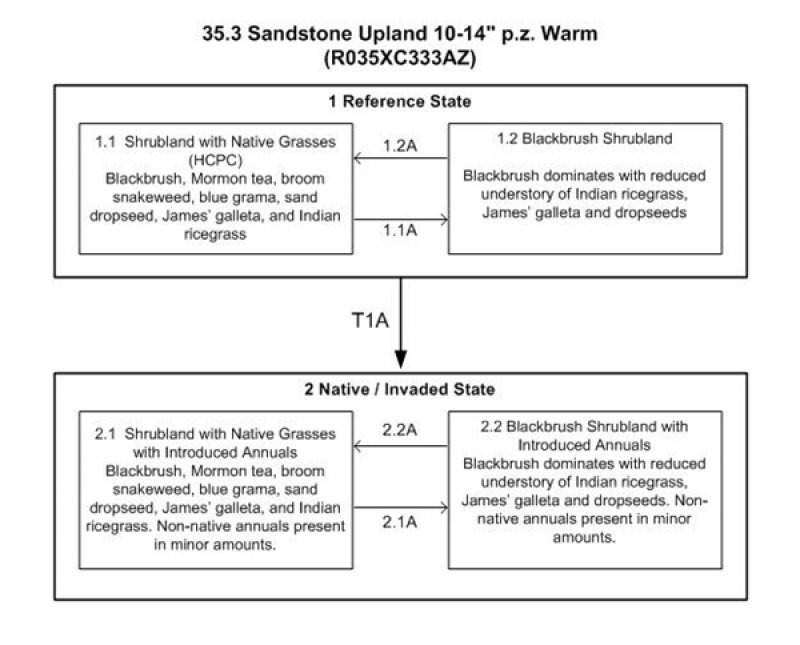
Figure 4. 35.3 Sandstone Upland 10-14"p.z. Warm
More interactive model formats are also available.
View Interactive Models
More interactive model formats are also available.
View Interactive Models
Click on state and transition labels to scroll to the respective text
Ecosystem states
State 1 submodel, plant communities
State 2 submodel, plant communities
State 1
Reference State
The dominate aspect is a shrub canopy of blackbrush with lesser amounts of Mormon tea, fourwing saltbush, Stansbury cliffrose and Bigelow sagebrush. Common grasses include blue grama, sand dropseed, James' galleta and Indian ricegrass. Blackbrush appears to act as a paleo-endemic species in this MLRA and may not be able to or be very slow to reestablish itself after significient disturbance. Plants likely to increase are annual grasses and forbs, perennial forbs and broom snakweed. Plants likely to invade and become established are cheatgrass, Russian thistle and red brome.
Community 1.1
Shrubland with Native Perennial Grasses

Figure 5. 35.3 Sandstone Upland, Warm
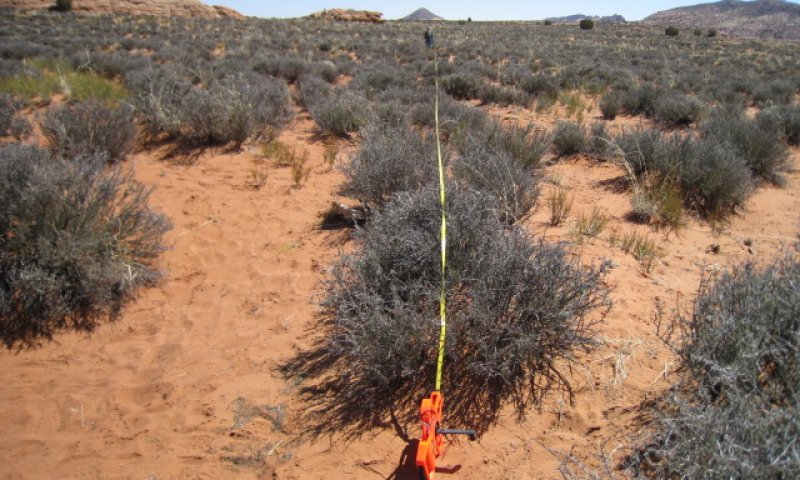
Figure 6. Sandstone Upland 10-14" p.z. Warm
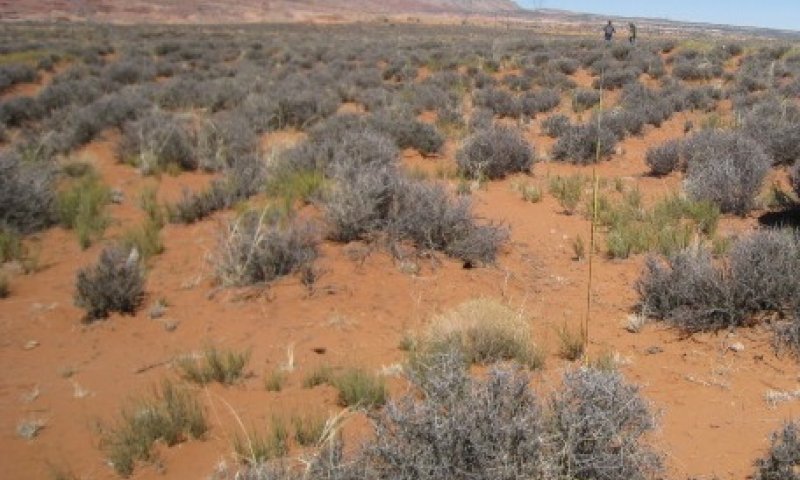
Figure 7. Low Precipitation Site
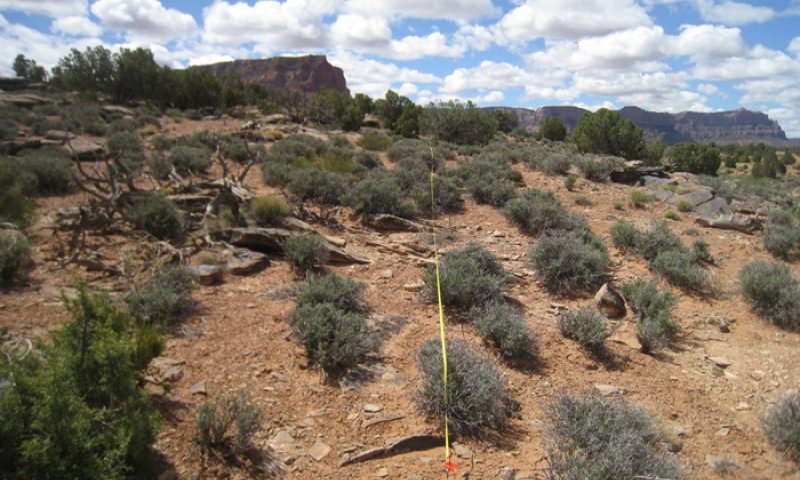
Figure 8. Higher Precipitation Site
This plant community is dominated by blackbrush with scattered perennial grasses and half-shrubs. Common grasses include blue grama, sand dropseed, Indian ricegrass, James' galleta, black grama, squirreltail and sixweeks fescue. Other shrubs commonly found include Mormon tea, Stansbury cliffrose, Bigelow sagebrush, narrowleaf yucca, fourwing saltbush, broom snakeweed and pricklypear.
Figure 9. Annual production by plant type (representative values) or group (midpoint values)
Table 5. Annual production by plant type
| Plant type | Low (lb/acre) |
Representative value (lb/acre) |
High (lb/acre) |
|---|---|---|---|
| Shrub/Vine | 250 | 300 | 350 |
| Grass/Grasslike | 55 | 75 | 85 |
| Forb | 10 | 15 | 20 |
| Tree | 0 | 5 | 10 |
| Total | 315 | 395 | 465 |
Table 6. Ground cover
| Tree foliar cover | 0-1% |
|---|---|
| Shrub/vine/liana foliar cover | 5-20% |
| Grass/grasslike foliar cover | 1-5% |
| Forb foliar cover | 1-3% |
| Non-vascular plants | 0% |
| Biological crusts | 0-15% |
| Litter | 5-15% |
| Surface fragments >0.25" and <=3" | 0-35% |
| Surface fragments >3" | 0-35% |
| Bedrock | 0-25% |
| Water | 0% |
| Bare ground | 15-45% |
Table 7. Canopy structure (% cover)
| Height Above Ground (ft) | Tree | Shrub/Vine | Grass/ Grasslike |
Forb |
|---|---|---|---|---|
| <0.5 | – | 0-5% | 0-3% | 0-1% |
| >0.5 <= 1 | – | 5-10% | 1-5% | 0-1% |
| >1 <= 2 | – | 5-20% | 0-2% | – |
| >2 <= 4.5 | 0-2% | 0-2% | – | – |
| >4.5 <= 13 | 0-2% | – | – | – |
| >13 <= 40 | – | – | – | – |
| >40 <= 80 | – | – | – | – |
| >80 <= 120 | – | – | – | – |
| >120 | – | – | – | – |
Figure 10. Plant community growth curve (percent production by month). AZ3503, 35.3 10-14" p.z. galleta. Growth begins in spring, most growth occurs during summer and early fall rainy season. Plants will green up again in the fall..
| Jan | Feb | Mar | Apr | May | Jun | Jul | Aug | Sep | Oct | Nov | Dec |
|---|---|---|---|---|---|---|---|---|---|---|---|
| J | F | M | A | M | J | J | A | S | O | N | D |
| 0 | 0 | 0 | 0 | 5 | 20 | 15 | 20 | 30 | 10 | 0 | 0 |
Figure 11. Plant community growth curve (percent production by month). AZ3504, 35.3 10-14" p.z. bottlebrush squirreltail. Growth occurs in late winter, spring, and fall. Plants often remain green through the winter..
| Jan | Feb | Mar | Apr | May | Jun | Jul | Aug | Sep | Oct | Nov | Dec |
|---|---|---|---|---|---|---|---|---|---|---|---|
| J | F | M | A | M | J | J | A | S | O | N | D |
| 0 | 5 | 15 | 35 | 25 | 10 | 0 | 0 | 5 | 5 | 0 | 0 |
Figure 12. Plant community growth curve (percent production by month). AZ3505, 35.3 10-14" p.z. Indian ricegrass. Growth begins in spring, with semi-dormancy occurring during July through August. Plants will green up again in the fall..
| Jan | Feb | Mar | Apr | May | Jun | Jul | Aug | Sep | Oct | Nov | Dec |
|---|---|---|---|---|---|---|---|---|---|---|---|
| J | F | M | A | M | J | J | A | S | O | N | D |
| 0 | 0 | 10 | 20 | 25 | 20 | 5 | 5 | 10 | 5 | 0 | 0 |
Figure 13. Plant community growth curve (percent production by month). AZ3506, 35.6 13-17" p.z. blue grama. Growth occurs mostly in summer and early fall during the rainy season..
| Jan | Feb | Mar | Apr | May | Jun | Jul | Aug | Sep | Oct | Nov | Dec |
|---|---|---|---|---|---|---|---|---|---|---|---|
| J | F | M | A | M | J | J | A | S | O | N | D |
| 0 | 0 | 0 | 5 | 10 | 15 | 25 | 30 | 15 | 0 | 0 | 0 |
Figure 14. Plant community growth curve (percent production by month). AZ3531, 35.3 10-14" p.z. all sites. Growth begins in the spring and continues through the summer..
| Jan | Feb | Mar | Apr | May | Jun | Jul | Aug | Sep | Oct | Nov | Dec |
|---|---|---|---|---|---|---|---|---|---|---|---|
| J | F | M | A | M | J | J | A | S | O | N | D |
| 0 | 1 | 3 | 17 | 18 | 10 | 19 | 20 | 10 | 1 | 1 | 0 |
Figure 15. Plant community growth curve (percent production by month). AZ3536, Black Grama. Grows mainly on summer precipitation..
| Jan | Feb | Mar | Apr | May | Jun | Jul | Aug | Sep | Oct | Nov | Dec |
|---|---|---|---|---|---|---|---|---|---|---|---|
| J | F | M | A | M | J | J | A | S | O | N | D |
| 0 | 0 | 0 | 0 | 5 | 5 | 30 | 50 | 10 | 0 | 0 | 0 |
Figure 16. Plant community growth curve (percent production by month). AZ5104, 35.3 10-14" p.z. sand dropseed. Growth begins in spring and extends into the fall..
| Jan | Feb | Mar | Apr | May | Jun | Jul | Aug | Sep | Oct | Nov | Dec |
|---|---|---|---|---|---|---|---|---|---|---|---|
| J | F | M | A | M | J | J | A | S | O | N | D |
| 0 | 0 | 0 | 5 | 10 | 5 | 30 | 35 | 15 | 0 | 0 | 0 |
Figure 17. Plant community growth curve (percent production by month). AZ5105, Blackbrush. Cool season grower, shuts down quickly when it gets hot..
| Jan | Feb | Mar | Apr | May | Jun | Jul | Aug | Sep | Oct | Nov | Dec |
|---|---|---|---|---|---|---|---|---|---|---|---|
| J | F | M | A | M | J | J | A | S | O | N | D |
| 0 | 5 | 20 | 50 | 20 | 5 | 0 | 0 | 0 | 0 | 0 | 0 |
Community 1.2
Blackbrush Shrubland
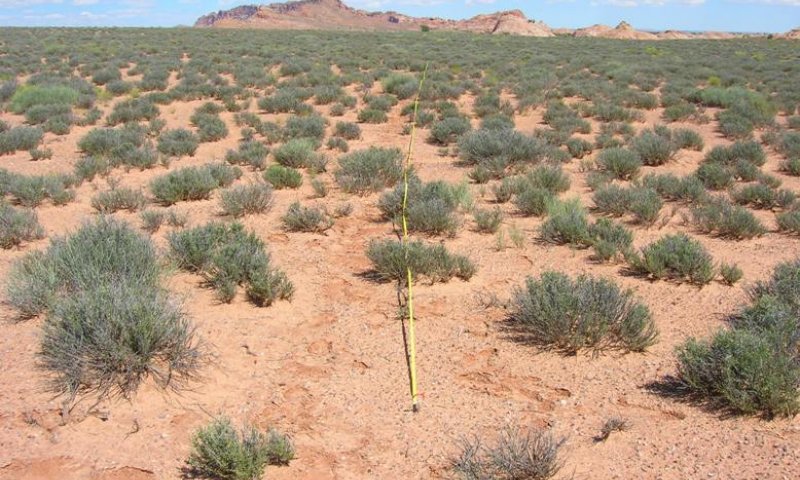
Figure 18. Blackbrush Dominated Plant Community
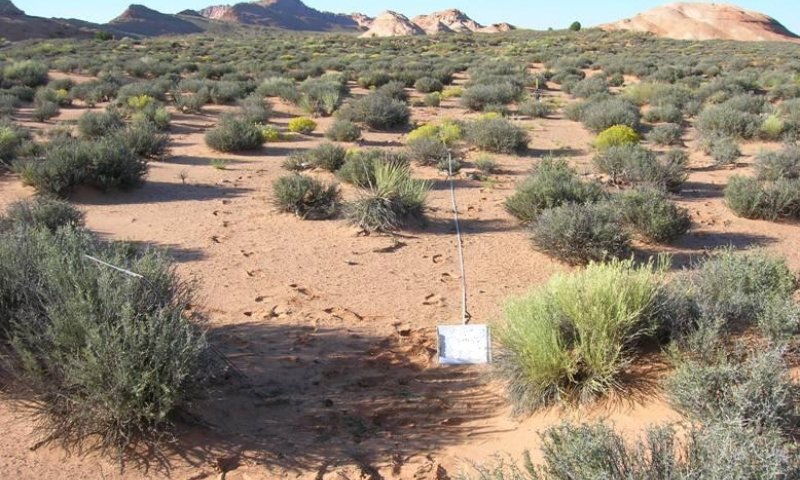
This plant community is dominated by blackbrush with scattered perennial warm season grasses and half-shrubs. Common grasses include blue grama, sand dropseed, James' galleta, Indian ricegrass. Other shrubs commonly found include Mormon tea, narrowleaf yucca, and broom snakeweed. There is a decline in perennial grasses and shrubs, such as fourwing saltbush and Bigelow sagebrush. Plant community composition by weight are about 75-95 percent for shrubs, 1-10 percent for grasses, 1-15 percent for forbs, and less than 5 percent for trees. There is an increase in bare ground as herbaceous cover decreases in shrub interspaces.
Pathway 1.1A
Community 1.1 to 1.2


Continous livestock grazing, prolonged drought, surface disturbance reduces herbaceous cover.
Pathway 1.2A
Community 1.2 to 1.1


Prescribed grazing or Rest, favorable climate or time for recovery allows for increase cover of perennial herbaceous species.
State 2
Introduced Non-Natives State
This state is similar to the Reference State, but non-native annual grasses and forbs have been introduced into the plant community. In the plant communities phases of the Introduced Non-Native State is the amount of annual grasses and forbs is only a small amount (1-3%), but will fluctuate slightly from year to year due to fluctuations in the amount and timing of precipitation. Normal soil surface disturbance expected from moderate levels of livestock grazing may cause the amount of non-native annual grasses and forbs to increase slightly.
Community 2.1
Shrubland/ Native Perennial Grasses with Introduced Annuals
Introduced non-native annual grasses and forbs are present in minor amounts (1-3%) in the plant community, but the amount and proportions of native plants is similar to that found in plant community 1.1, Shrubland with Perennial Native Grasses.
Community 2.2
Blackbrush Shrubland with Introduced Annuals
Introduced non-native annual grasses and forbs are present in minor amounts (1-3%) in the plant community, but the amount of native plants is similar to that of 1.2, Blackbrush Shrubland.
Pathway 2.1A
Community 2.1 to 2.2
Continous livestock grazing, prolonged drought, surface disturbance reduces herbaceous cover.
Pathway 2.2A
Community 2.2 to 2.1
Prescribed grazing or Rest, favorable climate or time for recovery allows for increase cover of perennial herbaceous species.
Transition T1A
State 1 to 2
The introduction of non-native annual grasses and forbs creates an irreversible change in the plant community.
Additional community tables
Table 8. Community 1.1 plant community composition
| Group | Common name | Symbol | Scientific name | Annual production (lb/acre) | Foliar cover (%) | |
|---|---|---|---|---|---|---|
|
Grass/Grasslike
|
||||||
| 1 | Dominant Grasses | 35–75 | ||||
| blue grama | BOGR2 | Bouteloua gracilis | 20–40 | – | ||
| sand dropseed | SPCR | Sporobolus cryptandrus | 15–30 | – | ||
| Indian ricegrass | ACHY | Achnatherum hymenoides | 5–10 | – | ||
| 2 | Other Perennial Grasses | 10–15 | ||||
| Grass, perennial | 2GP | Grass, perennial | 8–12 | – | ||
| desert needlegrass | ACSP12 | Achnatherum speciosum | 0–4 | – | ||
| black grama | BOER4 | Bouteloua eriopoda | 0–4 | – | ||
| squirreltail | ELELE | Elymus elymoides ssp. elymoides | 0–4 | – | ||
| prairie Junegrass | KOMA | Koeleria macrantha | 0–4 | – | ||
| sandhill muhly | MUPU2 | Muhlenbergia pungens | 0–4 | – | ||
| James' galleta | PLJA | Pleuraphis jamesii | 0–4 | – | ||
| 3 | Annual Grasses | 1–5 | ||||
| Grass, annual | 2GA | Grass, annual | 1–4 | – | ||
| sixweeks fescue | VUOC | Vulpia octoflora | 0–4 | – | ||
|
Forb
|
||||||
| 4 | Dominant Forbs | 10–20 | ||||
| Forb, annual | 2FA | Forb, annual | 12–20 | – | ||
| fiddleneck | AMSIN | Amsinckia | 0–8 | – | ||
| plantain | PLANT | Plantago | 0–8 | – | ||
| 5 | Other Forbs | 1–5 | ||||
| Forb, perennial | 2FP | Forb, perennial | 1–4 | – | ||
| milkvetch | ASTRA | Astragalus | 0–4 | – | ||
| phlox | PHLOX | Phlox | 0–4 | – | ||
| paperflower | PSILO3 | Psilostrophe | 0–4 | – | ||
| globemallow | SPHAE | Sphaeralcea | 0–4 | – | ||
|
Shrub/Vine
|
||||||
| 6 | Dominant Shrubs | 250–300 | ||||
| blackbrush | CORA | Coleogyne ramosissima | 240–300 | – | ||
| Cutler's jointfir | EPCU | Ephedra cutleri | 12–20 | – | ||
| Nevada jointfir | EPNE | Ephedra nevadensis | 12–20 | – | ||
| 7 | Other Shrubs | 20–50 | ||||
| Shrub (>.5m) | 2SHRUB | Shrub (>.5m) | 15–25 | – | ||
| Bigelow sage | ARBI3 | Artemisia bigelovii | 0–5 | – | ||
| fourwing saltbush | ATCA2 | Atriplex canescens | 0–5 | – | ||
| Stansbury cliffrose | PUST | Purshia stansburiana | 0–5 | – | ||
| turpentinebroom | THMO | Thamnosma montana | 0–5 | – | ||
| mormon tea | EPVI | Ephedra viridis | 0–3 | – | ||
| hedgehog cactus | ECHIN3 | Echinocereus | 0–3 | – | ||
| Cutler's jointfir | EPCU | Ephedra cutleri | 0–2 | – | ||
| Eastern Mojave buckwheat | ERFAP | Eriogonum fasciculatum var. polifolium | 0–2 | – | ||
| grizzlybear pricklypear | OPPOH | Opuntia polyacantha var. hystricina | 0–2 | – | ||
| narrowleaf yucca | YUAN2 | Yucca angustissima | 0–2 | – | ||
|
Tree
|
||||||
| 8 | Dominant Trees | 0–12 | ||||
| Utah juniper | JUOS | Juniperus osteosperma | 0–12 | – | ||
| 9 | Trees | 0–10 | ||||
| Tree | 2TREE | Tree | 0–8 | – | ||
| twoneedle pinyon | PIED | Pinus edulis | 0–4 | – | ||
Interpretations
Animal community
This site is suitable for grazing during any period of the year by cows and calves, stocker cattle, sheep and horses. Prescribed grazing systems can benefit this site by allowing rest periods for the cool season species.
The potential plant community provides a variety of food and cover plants for wildlife. When the vegetation complex retrogresses then unpalatable shrub species increase and the site becomes less usable as a foraging area for some species. Grazing practices that encourage cool season grass species are beneficial to antelope, cottontails and rodents. Shrubs that provide both food and cover should be maintained.
Recreational uses
Site is located on gently sloping plains and mesa tops which lend themselves to activities such as horseback riding, hiking, wildlife observation, photography and hunting.
Winters are cold, however, relatively mild spring, fall and summer months are attractive to recreationists.
Supporting information
Type locality
| Location 1: Coconino County, AZ | |
|---|---|
| Township/Range/Section | T41N R7E S8 |
| General legal description | Water Pockets 7 1/2 min quad, about 15 mi NW of Page on the east side of Cedar Mountain. |
Other references
Updates and revisions for this ESD were conducted as part of a 2007-2012 Interagency Technical Assistance Agreement between the Bureau of Indian Affairs–Navajo Region and the NRCS-Arizona.
Contributors
Dan Carroll
Kenneth Gishi
Larry D. Ellicott
SEC
Steve Barker
Approval
Kendra Moseley, 5/19/2025
Rangeland health reference sheet
Interpreting Indicators of Rangeland Health is a qualitative assessment protocol used to determine ecosystem condition based on benchmark characteristics described in the Reference Sheet. A suite of 17 (or more) indicators are typically considered in an assessment. The ecological site(s) representative of an assessment location must be known prior to applying the protocol and must be verified based on soils and climate. Current plant community cannot be used to identify the ecological site.
| Author(s)/participant(s) | Kenneth Gishi |
|---|---|
| Contact for lead author | State Rangeland Management Specialist, NRCS-Arizona State Office, Phoenix,AZ |
| Date | 03/09/2012 |
| Approved by | Kendra Moseley |
| Approval date | |
| Composition (Indicators 10 and 12) based on | Annual Production |
Indicators
-
Number and extent of rills:
Not expected due to coarse textured soils, variable rock cover and low slopes. On steepest slopes very few rills may occur and will be less than 10 feet in length, especially where adjacent to exposed bedrock. -
Presence of water flow patterns:
Generally none expected on most slopes, but a few short (3-5 feet) water flow patterns may occur on steeper slopes. -
Number and height of erosional pedestals or terracettes:
Very few pedestals around long-lived plants along established water flow patterns on steeper slopes. Some soil mounding or deposition is common around shrubs and is common and should not be confused with erosional pedestals. -
Bare ground from Ecological Site Description or other studies (rock, litter, lichen, moss, plant canopy are not bare ground):
15-45%. The amount of bare ground can vary widely depending on the amount of rock fragments, bedrock, and biological crust present on the site -
Number of gullies and erosion associated with gullies:
None, there should be no active gullies on this site. -
Extent of wind scoured, blowouts and/or depositional areas:
There can be some deposition (1”-2”) around long lived shrubs and perennial shrubs. -
Amount of litter movement (describe size and distance expected to travel):
Fine litter is transported by wind and water in plant interspaces. Woody litter should not move from beneath shrubs and trees. -
Soil surface (top few mm) resistance to erosion (stability values are averages - most sites will show a range of values):
This site should have an average soil stability rating of 3, with a rating of 3 to 4 under plant canopies and a rating of 2 to 3 in interspaces. Surface textures range from sand to gravelly loamy fine sand to sandy loam. -
Soil surface structure and SOM content (include type of structure and A-horizon color and thickness):
The soil surface typically ranges from 4 to 12” thick. Structure is mostly single grain, loose to weak medium platy. Color ranges from light red (2.5YR 6/6) to strong brown (7.5YR 5/6). -
Effect of community phase composition (relative proportion of different functional groups) and spatial distribution on infiltration and runoff:
This site is characterized by a dominance of shrubs, grasses and forbs in descending order. Soils on site have rapid to very rapid permeability. High shrub canopy with scattered bunch grasses reduce raindrop impact allowing for optimum infiltration. Prolong droughts reduces perennial grass cover which can cause a decreased infiltration, especially during intense storm events. -
Presence and thickness of compaction layer (usually none; describe soil profile features which may be mistaken for compaction on this site):
None expected due to coarse textured soils. -
Functional/Structural Groups (list in order of descending dominance by above-ground annual-production or live foliar cover using symbols: >>, >, = to indicate much greater than, greater than, and equal to):
Dominant:
Evergreen shrubs (blackbrush, Ephedra) >>Sub-dominant:
Warm seasoning grasses > Cool season grasses > other shrubs > perennial forbs > annual forbsOther:
Additional:
-
Amount of plant mortality and decadence (include which functional groups are expected to show mortality or decadence):
In years with normal to above normal precipitation there should be only slight mortality or decadence in shrubs or grasses. Only in severe prolong droughts will there be a significant mortality in shrubs and perennial bunch grasses. It should be noted that in periods of water stress blackbrush will drop its leaves. -
Average percent litter cover (%) and depth ( in):
The amount of litter cover will vary with different climatic conditions on the site. Litter distribution and depth will differ in plant interspaces and under canopies. Litter depth will be higher, up to 1/4”, under canopies. Litter amounts will increase in the first years of drought and decrease in the later years of a drought. -
Expected annual annual-production (this is TOTAL above-ground annual-production, not just forage annual-production):
Average annual production on this site is expected to be 350 to 400 lbs/ac in a year of average annual production. -
Potential invasive (including noxious) species (native and non-native). List species which BOTH characterize degraded states and have the potential to become a dominant or co-dominant species on the ecological site if their future establishment and growth is not actively controlled by management interventions. Species that become dominant for only one to several years (e.g., short-term response to drought or wildfire) are not invasive plants. Note that unlike other indicators, we are describing what is NOT expected in the reference state for the ecological site:
Broom snakeweed, Ephedra species, wavyleaf oak are all native to the site, but have the potential to increase on degraded sites. Russian thistle, cheatgrass, and other introduced annuals have the potential to invade the site. -
Perennial plant reproductive capability:
All plants native to the site are adapted to the climate and capable of producing seeds, stolons and/or rhizomes except during the most severe droughts.
Print Options
Sections
Font
Other
The Ecosystem Dynamics Interpretive Tool is an information system framework developed by the USDA-ARS Jornada Experimental Range, USDA Natural Resources Conservation Service, and New Mexico State University.
Click on box and path labels to scroll to the respective text.